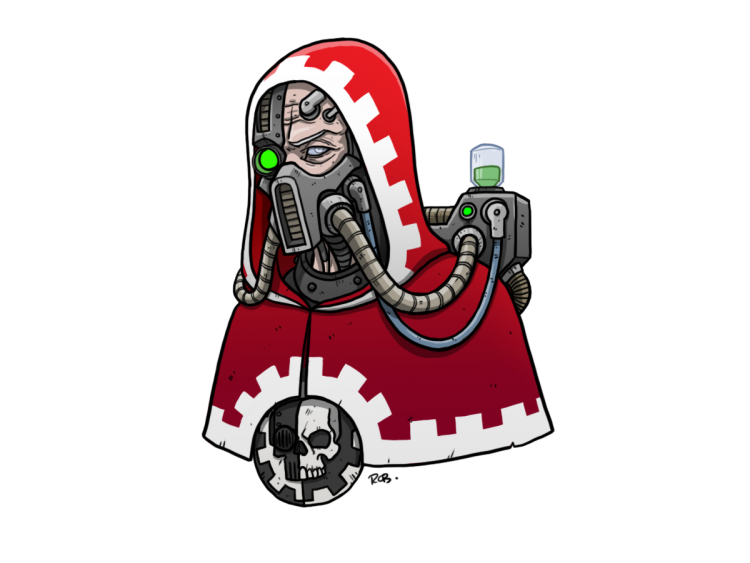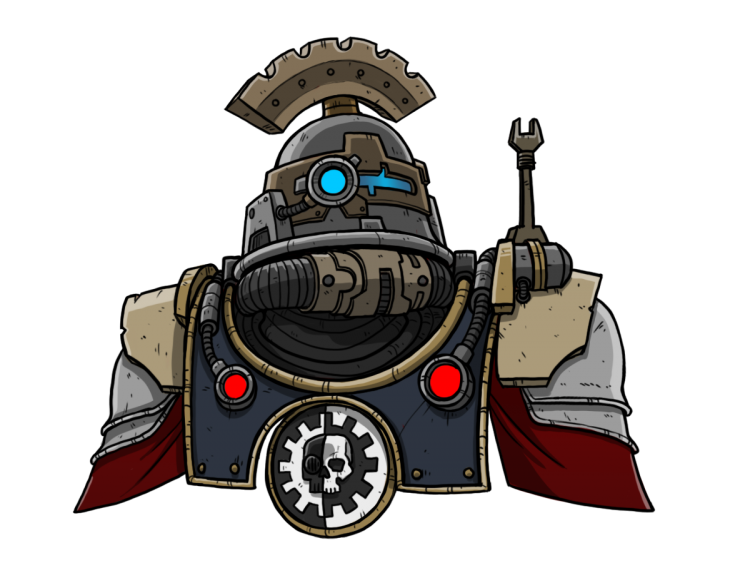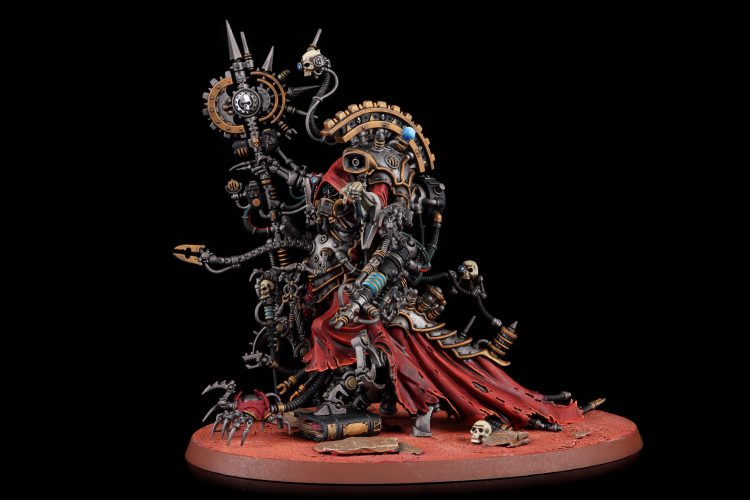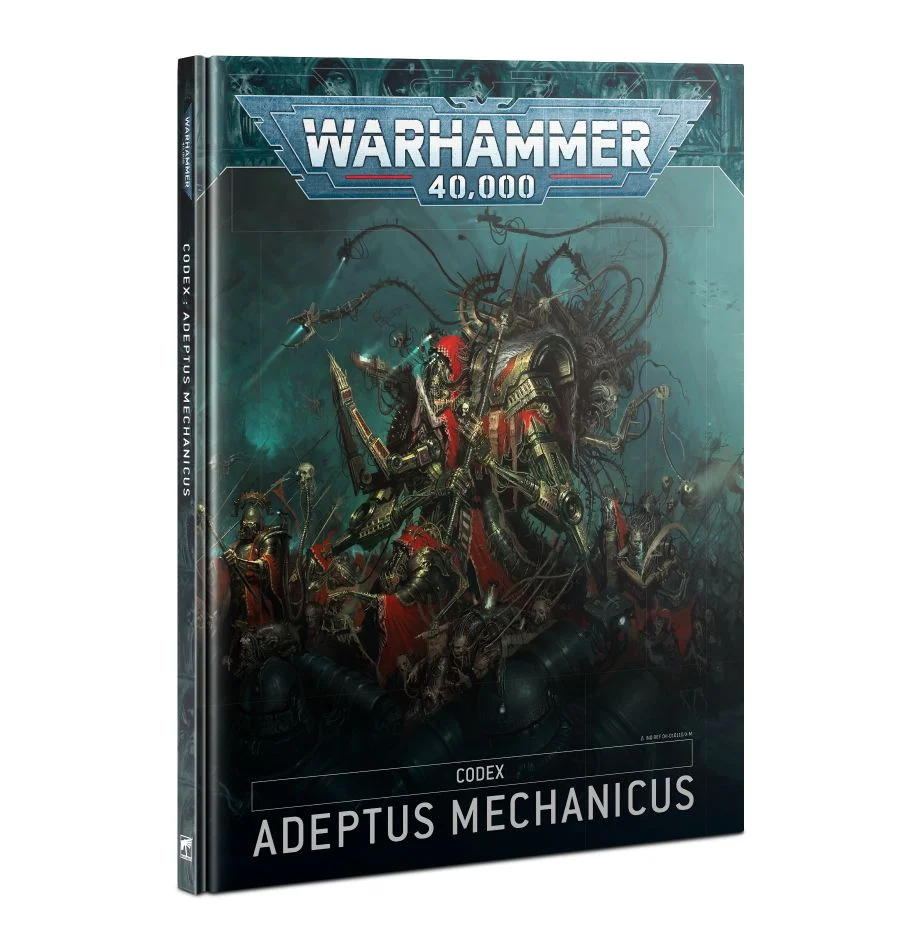The armies and factions of Warhammer 40,000 are all brutal and impressive in their own ways. As new books release, we dive into the lore presented in each, and how it shapes the fictional universe we love and make war in. In today’s review, Robert “TheChirurgeon” Jones is diving into the lore presented in the new 9th edition Codex: Adeptus Mechanicus to look at how the faction’s lore has changed over the last three editions. Goonhammer was provided with a review copy of this book by Games Workshop.
The Adeptus Mechanicus have been around for a long time in Warhammer 40,000. They’ve been mentioned and had rules as early as first edition/Rogue Trader, followed by some rules in the 2nd edition Codex Imperialis book that were never followed up with a Codex. As a faction, the technological and manufacturing arm of the Imperium sat on the sidelines for more than 25 years, during which time Games Workshop seemed to struggle with the notion of how to translate the army into a fully fledged army in the 40k universe. It wasn’t until 7th edition that the Adeptus Mechanicus would finally receive a full release, and even then it came split into two parts: Skitarii and Cult Mechanicus, for reasons that can only be described as… somewhat misguided. Fortunately, those issues were rectified in 8th edition and the Mechanicus line has exploded from a few small units to one of the game’s most visually striking armies.

Disciples of the Machine God
Headquartered on Mars, the Adeptus Mechanicus have a monopoly on the use, construction, and modification of technology within the Imperium, from black powder rifles on primitive worlds to the city-destroying warmachines of the Adeptus Titanicus. Such is their power and jurisdiction that even modifying a machine or tinkering with its inner workings without the blessings of a tech priest is a crime for which the punishment can be lobotomization and transformation into an automated servitor, a cybernetic slave of the mechanicus. If that sounds harsh well, the Cult Mechanicus are less like tech savants and more like a technophiliac cult of religious fanatics who worship technology and its use under the holy trinity of the Machine God, the Omnissiah, and the Motive Force, their own Father/Son/Holy Spirit combination. Whatever knowledge and genuine insight once lay within the tech-adepts of the Mechanicus has long been replaced by superstition and a reverence for old technology that has turned them into a fanatical cargo cult – they do not innovate and invent but rather hunt down and copy the designs of the past, and any true understanding of their technology and practices has been replaced by ritual and dogma.
Remember when you used to believe that blowing on your Nintendo cartridges would make them work? Blowing on your cartridges isn’t what made them work – removing them and putting them back in gave you a second shot at getting a good connection between the cartridge’s copper connectors and the pins in your NES cartridge port. But you believed it worked because one preceded the other and sometimes it appeared to work. But an entire generation of kids grew up doing this and would be more than happy to teach their kids to do it if we still used cartridges and hadn’t gone to CD-ROMs. Now imagine if you handed that tradition down for ten thousand years and your descendants believed that loading the holy cartridge into the computational entertainment recepticle required a 30-minute ritual in which the cartridge was anointed with holy oil before being blown on 12 times, then a brief prayer was said and litanies were changed as the cartridge was depressed and the holy power initializer switched to “ON.” That’s basically the level of bullshit the Cult Mechanicus are working on. Most of them have no idea what they’re doing or how any of this tech works; they’re just copying the processes they’ve been told.
Because of their devotion to technology, members of the Adeptus Mechanicus believe that organic matter is a weakness to be overcome and expunged; they seek to replace their physical, decaying bodies over time with cybernetic and mechanical enhancements. The more they replace, the closer they become to the machine god they worship. The Tech-priests of the Cult Mechanics do not exert their influence solely through the Imperium and its military institutions; the Adeptus Mechanicus maintains its own standing armies. These are made of war machines built by the Mechanicus like the Kastelan robots, battle-equipped servitors, and the cybernetic legions of the Skitarii. The Skitarii are cybernetic warriors devoted to the service of the machine god, heavily modified with bionic parts and brains programmed with martial expertise.

Credit: Pendulin
Mars
Mars is the holy seat of power for the Cult Mechanicus, the first Terran colony and a hollowed-out, irradiated wasteland covered and filled with technology constructed over millennia. At the center of it is the Tantalus Hive, which houses the Fabricator General of Mars, head of the Cult Mechanicus and one of the High Lords of Terra. The founding of the Cult Mechanicus predates the emergence of the Emperor and his Great Crusade by many millennia, and Mars was colonized well before the Age of Strife that laid waste to human galactic civilization but were no less affected by it. During that long period following the Dark Age of Technology the planet fell into ruin, technology was lost forever, and its citizenry were slowly indoctrinated and converted into a theocracy that worshipped the machine god. The Emperor’s first steps in reclaiming the galaxy led him to Mars, where he forged an alliance with the Tech-Priests, giving birth to the modern Mechanicum. For their part, the Mechanicum were allowed to continue their worship but recognized the Emperor as a being called the Omnissiah, a living embodiment and instrument of the machine god and its will. Though not all agreed – when the galaxy was plunged into war during the Horus Heresy, fully half of the Adeptus Mechanicus rebelled, aligning itself to Horus’ cause.
While Mars is the oldest and most important of all Mechanicus forge worlds (and the mechanicus show loyalty to the red planet and its machine god by wearing crimson), it is far from the only one – there are many others of note, including Forge World Metalica.
The STC
Mentioned in the 40k Core Rules, the STC are Standard Template Constructs, devices left over from the Dark Age of Technology that can create machines using whatever materials are available, from farming equipment to engines of war. Many of the Imperium’s most ubiquitous weapons and technology are produced form recovered STC templates. As a result, any remnant or scrap of STC technology is considered a sacred relic to the Adeptus Mechanicus and will be something they attempt to recover at all cost.
Abominable Intelligence and Servitors
The Legio Cybernetica is “manned” by the battle-ready automatons of the Adeptus Mechanicus – large, humanoid robots programmed for war. The most common of these are Kastelan robots – ancient machines whose origin predates the Imperium, but for which the method and secretes of creation have been lost to time. However these robots are not powered by artificial – or as it’s known in the 41st millennium – abominable intelligence. One of mankind’s greatest mistakes during the Dark Age of Technology was in developing thinking machines, the Men of Iron, who eventually turned on their masters in a great war that would lead to the collapse of humanity’s galactic empire. Mechanicum automatons are instead created using fusions of biomatter electronics made from human brains on which simple instructions have been encoded. These are inserted into the Kastelans by Datasmiths during the heat of battle as new orders are needed, for programming intelligence into the robots is strictly forbidden.
Likewise, much of the Mechanicum’s labor is carried out by servitors, lobotomized cybernetic beings whose personalities have been removed and overwritten, turned into useful servants for the Imperium. These blank slates also provide a workaround to the creation of abominable intelligence.

War Zone: Metalica
The newest and most important War Zone for the Adeptus Mechanicus is the forge world Metalica, where forces of the Death Guard and hosts of daemons, led by Typhus, have descended upon the Charadon Sector and centered their efforts on the Metalica system. Although a concluded conflict in the 8th edition Codex: Adeptus Mechanicus, jumping back to the start of the Indomitus Crusade at 9th edition allows us to revisit this key conflict, which has been chronicled as well in The Book of Rust and Plague Purge supplements. As a forge world, Metalica is notable for maintaining its own titan legion and being proudly independent from Mars in doctrine, something they mark in their white heraldry and robes.

Credit: Pendulin
Belisarius Cawl
The Archmagos Dominus of the Adeptus Mechanicus (I’m not sure what that makes him but he seems to have a ridiculous amount of autonomy so he must be pretty high up), Cawl was already pretty old when the Imperium was born back in the year 30k. He’s smarter and a bit more daring than most Tech-priests, and he’s considered a genius among his peers, having forgotten more than most will ever learn (and having had his memory wiped multiple times). Over the last ten thousand years he’s invented dozens of weapons, uncovered a bunch of STCs, and gone out looking for all kinds of arcane and forgotten tech knowledge. The most important of these projects is the creation of the Primaris Space Marines and the Ultima Founding it made possible. With this act – first set into motion thousands of years prior – Cawl has revitalized the armies of the Imperium and made Guilliman’s reconquest possible.
Overall Thoughts
It’s difficult to come at this book from a newcomer’s angle since I’ve read most of the basic lore on the Admech over the last two codexes; as a result, the book feels somewhat incomplete – there’s enough primer content here on the structure of the Adeptus Mechanicus, but not nearly enough on the motivations – the STC is mentioned in passing under Cawl’s backstory entry, but largely missing from the rest of the text. While the Mechanicus can certainly quest after archaeotech that isn’t a working STC, it seems like a piece that’s conspicuously absent given its mention elsewhere. Likewise, the Charadon campaign is mentioned on a two-page spread, but only to describe the conflict on a single planet in the system; little time and space are devoted to what the conflict is, how it started, or what the stakes are – it feels like that’s all been moved to the Book of Rust and well, this doesn’t make a strong case to pick that book up. There’s some cool stuff here, and it’s a fine intro and overview to the faction, but as with many of the 9th edition codexes, there isn’t much of anything new for you to read if you’re familiar with the fluff and what is new tends to be light on details or the other stuff that makes it compelling. Something I really miss from the 8th edition codexes are the two+ page timeline spreads showing recent major events for a faction; those always had cool story hooks and I wish they were still doing them. Anyways, this is fine, but not amazing.
Have any questions or feedback? Drop us a note in the comments below or email us at contact@goonhammer.com.


